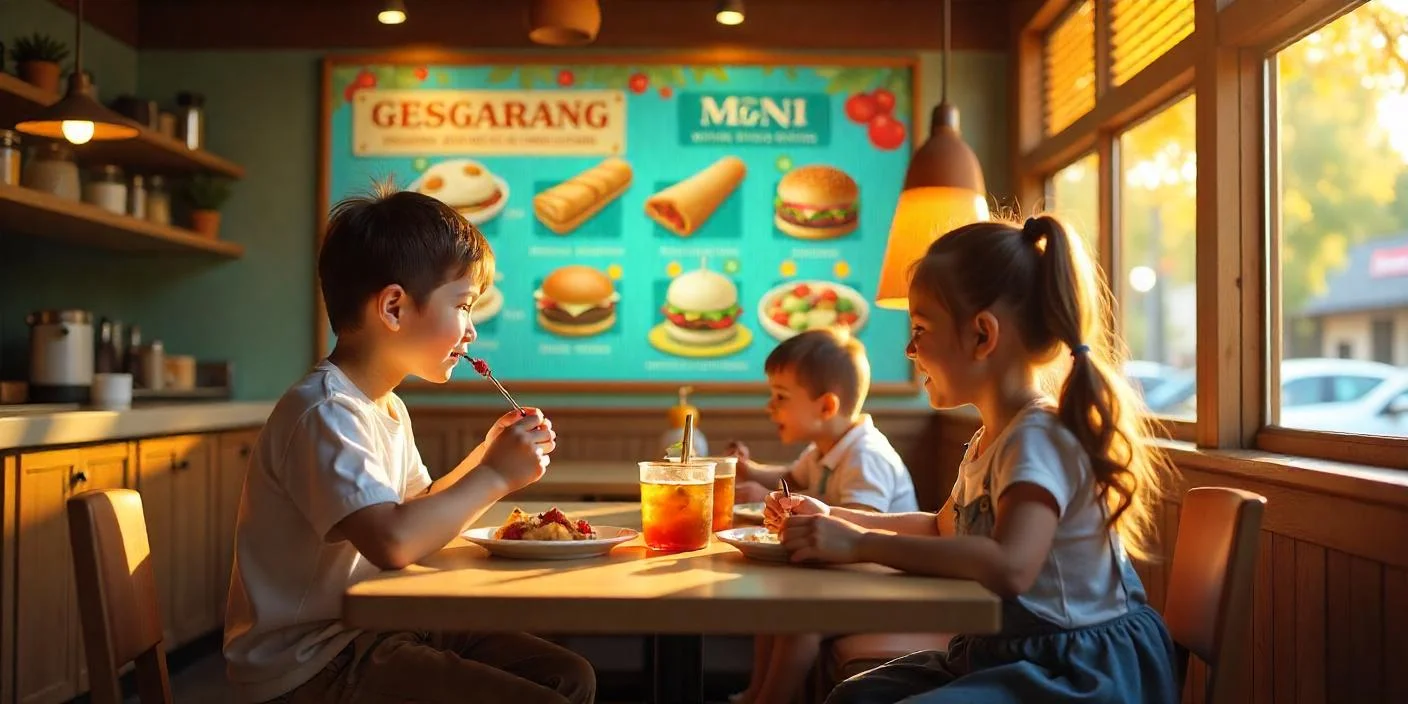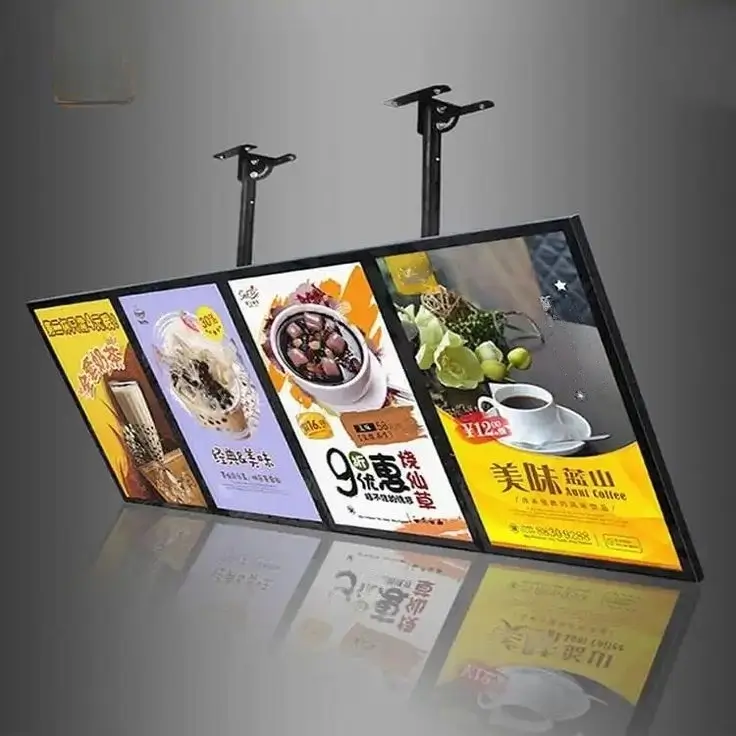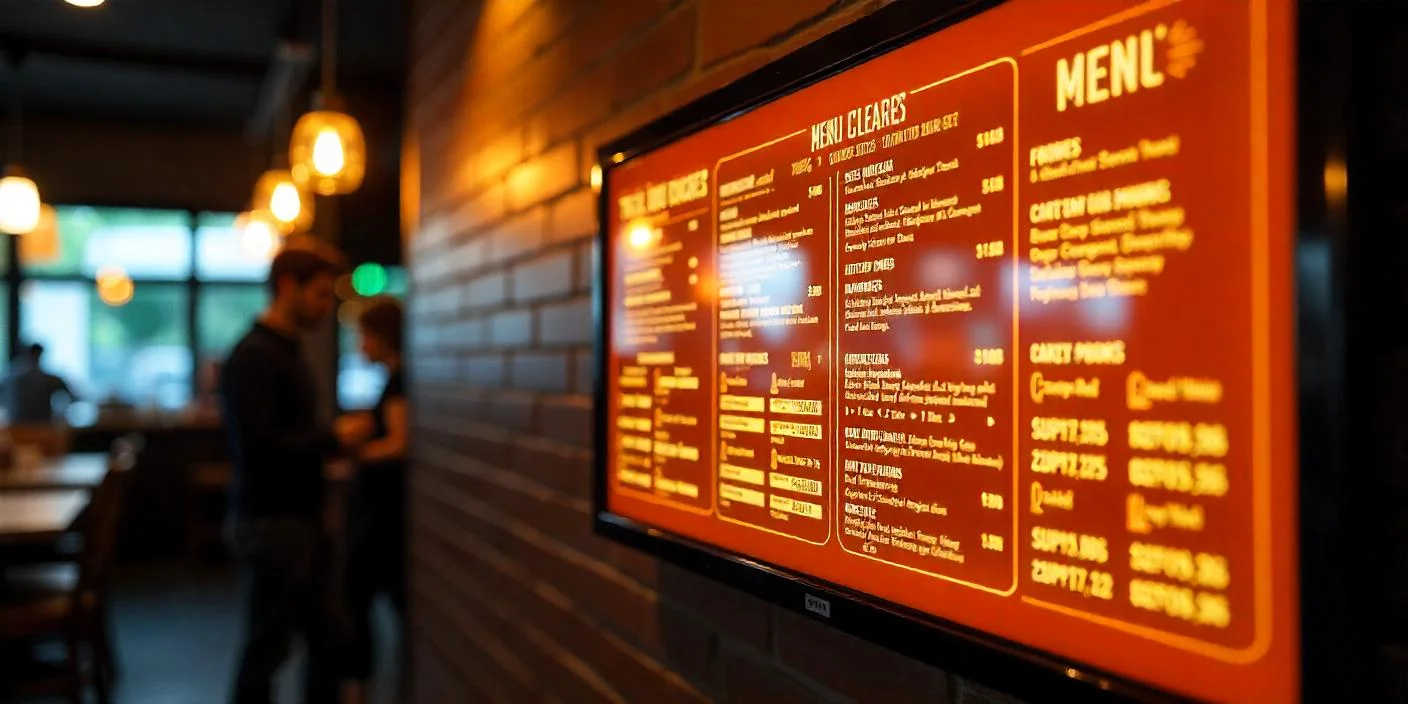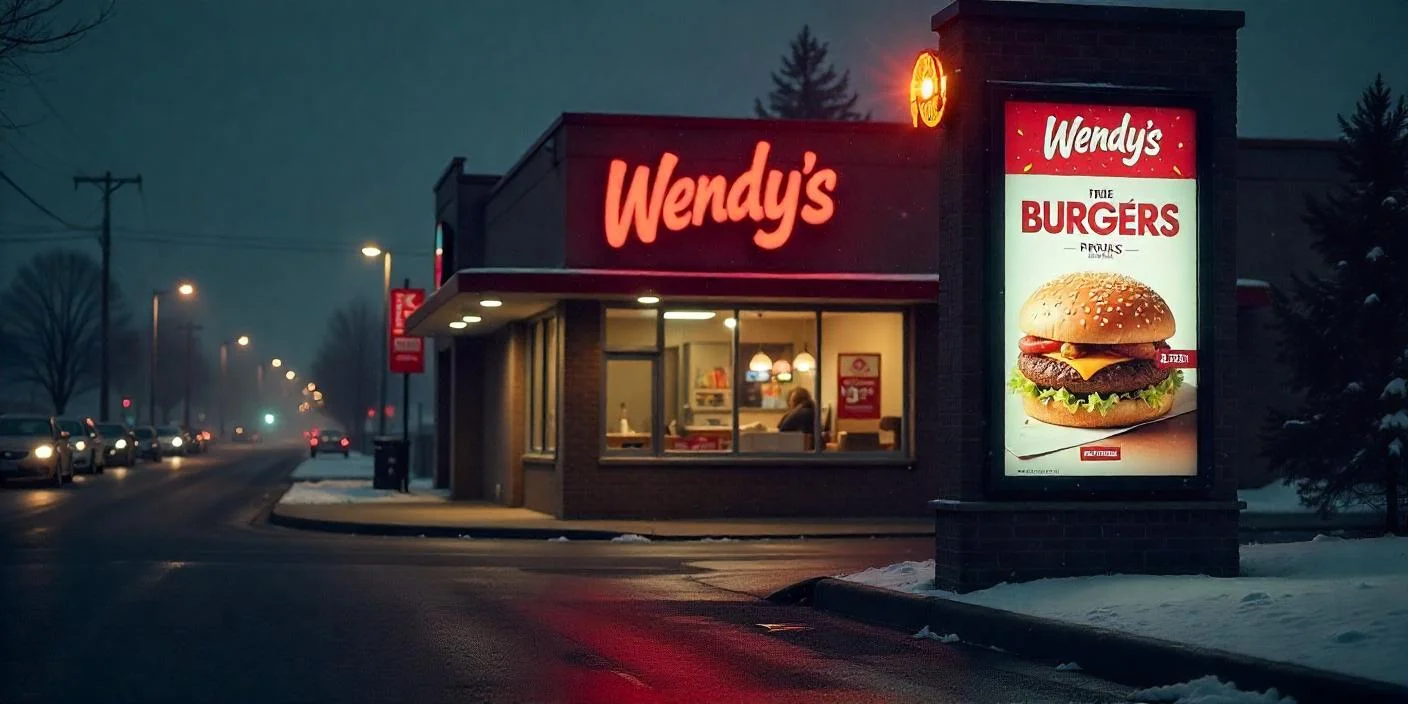The digitalization of the food industry is changing the dining experience in all aspects, and restaurant digital displays now form a key component in this revolution. These solutions include digital menu boards that update restaurant pricing in real time, freestanding menu kiosks that reduce wait times, and outdoor digital menu boards that attract the attention of passersby and improve brand identity, operations, and sales. This is an extensive guide on everything you need to know about digital displays for restaurants, whether it is the best digital display for restaurants or digital menu options, what it is, the types, its advantages, future trends, and frequently asked questions.
Introduction to Digital Displays in the Restaurant Industry

In the modern-day, dynamic, technology-driven society, diners are no longer satisfied with the traditional paper menus. Digital displays for restaurants provide in-depth interactive experiences, the innovation of visual appeal, dynamic content, and touchscreen ordering. With the digital display in restaurant solutions, the operators are able to engage guests even before they sit down, making memorable first impressions that lead to foot traffic and repeat visits.
Evolution of Menu Presentation in Restaurants
It has been a remarkable transformation as we go about the transition of chalkboards and laminated printouts to sleek restaurant menu screens. The initial LED sign boards have been replaced by high-resolution LCD panels, and the modern menus digital display systems are equipped with touchscreen interfaces, cloud content management, and digital signage solutions integration. This change is part of a wider trend towards agility- enabling restaurants to change menus on a dime using inventory, promotion, or customer response.
Types of Digital Displays for Restaurants
Wall-mounted Digital Displays
Wall-mounted digital displays are ideal for broadcasting menu items, daily specials, and promotional videos and are perfect for showing full-of-life visuals of signature dishes. They add to the brand consistency and modernity in your décor.
Freestanding Menu Kiosks
These restaurant-grade digital menu boards also function as self-ordering kiosks. Customers can easily customize their “Build-Your-Own Salad” or “Vegan Burger” and decrease the number of orders in the queue and mistakes in orders, as well as upsells with interactive on-screen suggestions.
Outdoor Digital Menu Boards
Outdoor digital menu boards are bright sunlight and adverse weather-resistant and can be used in any condition because they are designed with 1,500+ nits brightness and IP65-rated housings. The rapidity of content updates is an advantage of drive-thru operations, showing that breakfast is served until 11 AM or special summer smoothies.
Tabletop Digital Displays
Digital displays for restaurants on tables entertain guests during the process of eating. Slides of featured desserts, loyalty program signups, and feedback surveys all increase post-order ringing and customer retention through tabletop digital displays.
Benefits of Using Digital Displays in Restaurants
Aesthetics and Productivity of the Brand
Digital display on restaurant screens: High-resolution digital display provides sharp imagery and animations, making every location look like its flagship or franchise. Custom templates strengthen your logo, color palette, and tone on every menu screen in restaurants.
Real Time Update of Menus
There are no reprints or menu change fees anymore. Restaurant Digital Displays can edit pricing, availability, and promotional messages in real-time using a cloud CMS-keeping prices, availability, and promotions accurately and reacting quickly to market or inventory changes.
Upselling using Dynamic Content
Restaurants use animated transitions and specific banners on digital menu boards to highlight high-margin add-ons: “Buy fries and drink with your burger at an extra dollar.” Research indicates that dynamic upsell prompts have the ability to raise average check sizes by as much as 15 percent.
Increased Customer Experience
Menu digital displays eliminate confusion due to clear layout, allergen filtering, and multilingualism. Customers do not feel like they are kept in the dark and have no control, which breeds loyalty and good word-of-mouth.
Digital Menu Boards for Restaurants: A Closer Look
Restaurant digital menus have become the norm and provide distance legibility, dayparting, an
d split-screening. High-tech functionality- such as weather-based content (Warm Day? It keeps boards fresh and current, with hashtag #Foodie posts on social media integrations and Try Our Iced Tea! Transparency and regulatory compliance are provided by compliance functions, e.g., automatic calorie count and allergen displays.
Choosing the Best Digital Displays for Restaurants
When choosing the restaurant’s digital displays, take into consideration the following:
- Screen Quality: High brightness anti-glare panels both indoors and outdoors.
- Software Ease-of-Use: Drag-and-drop editors, digital menu solutions, and powerful scheduling.
- Hardware Durability: 24/7 screen rated as commercial grade and moisture or grease resistant.
- Integration Capabilities: Simple POS synchronization and API links to inventory and loyalty systems.
- Support & Scalability: Good technical support and the possibility to add screens as your business expands.
Comparing Traditional Menu Boards vs Digital Menu Solutions
The classic, fixed boards are manually updated and frequently reprinted, which means constant expenses and possibilities of errors. Digital menu solutions, on the other hand, such as digital menu boards in restaurants and digital sales boards, provide dynamic flexibility, savings, and creative control. Digital forms cut down on wastage, make marketing more consistent across stores and open up the power of advanced analytics to make data-driven marketing a reality.
Top Features of the Best Digital Menu Boards for Restaurants
High-Resolution Screens
Sharp text and delectable imagery of dishes require no less than 1080p HD resolution; 4K displays raise the bar even higher.
Remote Content Management
Oversee every digital display for your restaurant from a unified cloud dashboard—schedule, update, and pull content without having to visit the site.
POS Systems Integration
The synchronization of prices and inventory in real-time ensures that the menu display in your restaurant will always be up to date, avoids the disappointment of an out-of-stock purchase, and allows the creation of personalized promotions based on your purchase history.
Weather-Resistant Technology
Menus on outdoor digital displays must have solid enclosures and high brightness ratings to perform in the rain, sun, and wind.
Restaurant Menu Display Ideas for Enhanced Engagement
- Rotating Carousels: Cycle through highlighted dishes, chef bios, and seasonal specials on one digital display on the restaurant screen.
- Motion-Triggered Content: Sensors will recognize the presence of a guest and trigger promotional animations, which will attract attention toward limited-time offers.
- User-Generated Galleries: Showcase real-time social media posts using the hashtag of your restaurant to generate community using authentic customer content.
Menu Screens for Restaurants: Placement Strategies
- Restaurants: maximize the visibility and impact of menu screens:
- Entrance Displays: Grab the attention of passersby with high-impact images and previews of the menu on the sidewalk.
- Countertop Boards: Place small digital displays at point-of-sale to sell desserts or loyalty programs.
- Dining Area Screens: Enforce brand story and remind about future events or promotions during the meal.
Digital Display for Restaurant Drive-Thrus
Drive-thru lanes call for digital displays for restaurants that load content lightning-fast, deliver high-contrast readability, and provide unambiguous audio prompts. Multi-panel displays enable the display of standard menus, upsell areas, and even promotional videos at the same time, and they are optimized to make quick decisions.
Interactive Digital Displays for Self-Ordering
Interactive digital signage software on self-service orders and pay kiosks liberates staff to concentrate on hospitality as guests design their own food. Restaurant digital menu boards that are touch-enabled help minimize errors in orders, gather valuable data on preferences, and can also facilitate faster drive-thru.
Customization and Branding Opportunities
The possibilities of digital restaurant menus on display are endless: animated logos, seasonal theme replacements, video greetings of the chef, and branded loyalty reminders. In restaurants, digital displays act as open canvases, enabling you to project your identity into every frame.
Cost Considerations and ROI
Though the upfront costs of digital displays for restaurants are considerable, the resulting long-term ROI is highly attractive. Printing cost savings, upsell growth, labor savings, and data-driven marketing can pay back in 12-18 months.
Future Trends in Digital Menu Displays
- AI-Driven Recommendations: Analyzing time, weather, and customer type, displays recommend the ideal dish- just like a high-quality server would.
- Voice-Activated Menus: Hands-free communication with the help of voice commands makes them more accessible and faster in order.
- AR Menus: Customers view 3D realistic images of the food before making an order, which eliminates confusion and builds anticipation.
Grow with Digital Displays for Restaurants
Digital displays for restaurants are not only a fad but a competitive investment in improving guest experience, optimizing operations, and ensuring future proofing your business. When you implement the correct digital display solution in restaurants: a digital menu board, interactive kiosk, or colorful outdoor board, you will distinguish your brand and achieve long-term development.
Frequently Asked Questions (FAQs)
Q1: What are the best digital displays for restaurants?
You should seek out commercial-level LCD or LED displays with 1080p + resolution, cloud-based CMS, POS integration, and outdoor-friendly designs.
Q2: How do digital menu boards for restaurants improve sales?
Promoting offers, supporting dynamic upselling, shortening the queues, and sending personalized messages that will be more relevant to the guests.
Q3: Are digital menu solutions expensive to maintain?
No, it is really low-cost to maintain due to low power consumption, long-lasting hardware, and remote maintenance.
Q4: Can I use digital displays outdoors?
Indeed, outfitted with weatherproof housings, anti-glare finishes, and high-brightness outputs, outdoor digital displays for menus operate dependably in every climate.
Q5: What content works best on restaurant menu screens?
An optimal combination of high-resolution food videos, rotating specials, loyalty rewards, and guest testimonials will make the content fresh and interesting.
Q6: How long do digital displays last?
Top-tier commercial panels are engineered to operate for more than 50,000 hours without fail—which translates to more than five years of round-the-clock use.
Q7: Do I need specialized software?
Yes–the scheduling, user permissions, and analytics of a solid digital signage solution are essential. Nento’s platform delivers all these capabilities, along with pre-made digital menu board templates that make for a rapid launch.







